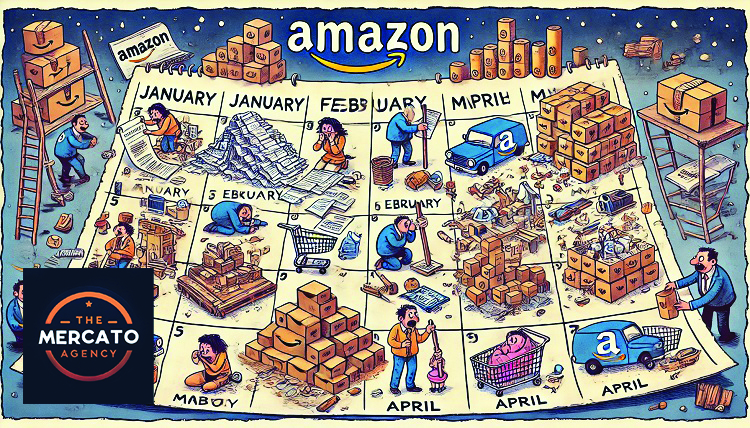Unlock the blueprint to Amazon success: a month-by-month strategy
Launching a successful Amazon business requires more than just listing a product online—it demands a strategic, data-driven approach to capture market attention, drive sales, and grow sustainably over time. With millions of products vying for customer attention, building a brand that stands out on Amazon can seem overwhelming.
This 12-month business strategy is designed to take you from the very first step of product research to scaling a profitable and customer-centric brand. By following this structured roadmap, you’ll not only navigate the complexities of Amazon’s ecosystem but also turn challenges into growth opportunities.
Months 1-2: Product Research and Store Setup
Market Research & Product Selection:
- Analyze market trends and customer needs.
- Use tools like JungleScout, Helium 10, and Amazon’s Best Sellers page to identify high-demand, low-competition products.
- Define the unique selling proposition (USP) of the product.
- Develop competitive pricing strategies based on research.
Supplier and Inventory Planning:
- Negotiate with suppliers to ensure high-quality products with competitive production costs.
- Calculate lead times, minimum order quantities, and shipping options.
- Establish relationships with manufacturers and finalize production timelines.
- Prepare for FBA (Fulfillment by Amazon) or FBM (Fulfilled by Merchant) fulfillment models.
Branding and Amazon Store Setup:
- Develop a strong brand identity (logo, packaging, etc.).
- Apply for Amazon Brand Registry for enhanced protection and marketing tools.
- Set up an Amazon Seller Central account.
- Start preparing product listings, including titles, bullet points, descriptions, and keyword research.
Month 3: Launch & Listing Optimization
Product Listing Finalization:
- Ensure listings are optimized with SEO-rich product titles, compelling descriptions, and clear, benefit-focused bullet points.
- Upload professional images and infographics showcasing product features and lifestyle shots.
- Use Amazon’s A+ Content (if enrolled in Brand Registry) to enhance product pages with custom text placements, images, and comparison charts.
Amazon PPC Setup:
- Launch low-budget Amazon Pay-Per-Click (PPC) campaigns, focusing on automatic targeting.
- Set up both sponsored product ads and brand ads for visibility.
- Use keyword research tools to target long-tail keywords for lower-cost bids.
Initial Reviews & Social Proof:
- Encourage initial reviews through Amazon’s Early Reviewer Program and Vine Program.
- Create a customer follow-up system via email to thank customers and request feedback (within Amazon’s guidelines).
Months 4-5: Building Momentum & Customer Acquisition
Scaling Amazon PPC Campaigns:
- Analyze PPC data, focusing on what keywords are driving conversions.
- Shift from automatic targeting to manual campaigns, optimizing high-performing keywords.
- Add negative keywords to reduce wasted spend.
Launch Promotions & Discounts:
- Run Amazon Lightning Deals or coupons to drive traffic and generate early sales volume.
- Leverage social media, influencers, and email marketing to drive external traffic to Amazon listings.
Inventory Management:
- Monitor stock levels closely to prevent stockouts and over-ordering.
- Adjust inventory levels based on sales trends and reorder from suppliers as needed.
Month 6: Expanding Reach and Building Customer Loyalty
Explore Additional Amazon Tools:
- Utilize Amazon’s Subscribe & Save for consumable products to increase repeat purchases.
- Enable Amazon’s Global Selling if the product has international demand.
Enhance Listings with Video Content:
- Add product demonstration videos to enhance product listings (if Brand Registered).
- Consider influencer-generated video content to highlight real-life usage.
Customer Retention Strategies:
- Use Amazon’s Post-Purchase Communication Tool to send follow-up emails, share usage tips, and promote related products.
Months 7-8: Data Optimization and Growth Expansion
Advanced PPC Strategy:
- Leverage Amazon’s advanced advertising features like Sponsored Display Ads and Product Targeting.
- Test different ad placements (product pages, search results) to optimize conversion rates.
A/B Testing Product Listings:
- Run A/B tests on images, titles, and descriptions using Amazon’s Manage Your Experiments tool.
- Implement changes that result in better conversion rates.
Content Creation & External Traffic:
- Create blog posts, YouTube videos, or social media content linking back to your Amazon store.
- Invest in influencer partnerships to drive traffic to your listings via external channels.
Months 9-10: Diversification and Expansion
Launch New Products:
- Analyze customer feedback and sales data from the first 6 months to identify opportunities for product line expansion.
- Launch complementary products or bundles to increase Average Order Value (AOV).
Amazon SEO Optimization:
- Continuously update product listings based on customer search behavior and keyword trends.
- Ensure your product is indexed for the right keywords and ranking well.
Increase Customer Lifetime Value:
- Implement cross-sell and upsell strategies by recommending related products in follow-up emails.
- Offer discounts or loyalty bonuses to encourage repeat purchases.
Month 11: Fine-Tuning Operations
Fine-Tune Logistics and Operations:
- Re-evaluate suppliers, shipping methods, and FBA fees to streamline costs and maximize profitability.
- Consider expanding into Amazon’s FBA Small and Light Program if applicable for cost savings.
Monitor Reviews and Customer Feedback:
- Closely monitor product reviews and ratings to ensure a high star rating.
- Respond to any negative feedback promptly and offer resolutions.
Expand into New Amazon Markets:
- Explore other Amazon marketplaces (Europe, Canada, Australia) if relevant to your product.
Month 12: Scaling and Maximizing Profitability
Maximize Profitability:
- Focus on products with the highest profit margins and double down on PPC for those items.
- Refine inventory to focus on best-selling products and phase out underperforming SKUs.
Brand Building Off-Amazon:
- Build your brand’s presence outside of Amazon through a website, social media, and email marketing.
- Start preparing for additional sales channels like your own e-commerce store.
Review and Set Future Goals:
- Evaluate the year’s performance: sales, profits, customer acquisition, and retention.
- Set clear goals for the next 12 months based on data-driven insights.
Summary of Key Milestones:
- Months 1-2: Product research, supplier setup, listing creation.
- Month 3: Launch with optimized listings and initial PPC.
- Months 4-5: Build momentum with PPC, promotions, and customer acquisition.
- Month 6: Focus on customer retention, expanding reach, and enhancing listings.
- Months 7-8: Optimize and expand with new products, A/B testing, and external traffic.
- Months 9-10: Diversify product range and optimize SEO.
- Months 11-12: Fine-tune operations, scale profitably, and review year-end performance.
By following this strategy, your brand will have a structured and data-driven approach to launch, scale, and optimize its presence on Amazon, maximizing long-term growth and profitability.
At The Mercato Agency, we can help you build your brand strategy on Amazon, use the free audit below to start your journey with us.






